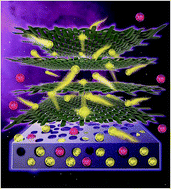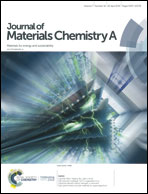Self-stacked multilayer FeOCl supported on a cellulose-derived carbon aerogel: a new and high-performance anode material for supercapacitors†
Abstract
To build high-energy density asymmetric supercapacitors (ASCs), current studies are always directed towards cathode materials; however, anode materials are paid much less attention. Here we for the first time demonstrate that orthorhombic FeOCl with a self-stacked laminated structure is suitable to be a high-performance anode material for supercapacitors since its unique laminated structure can provide abundant active sites for migration and intercalation reactions of electrolyte ions. By introducing a highly conductive and porous cellulose-derived carbon aerogel (CDCA) matrix, the mechanical stability and charge-storage kinetics of FeOCl are significantly enhanced. FeOCl@CDCA delivers an ultra-high areal specific capacitance of 1618 mF cm−2 (647 F g−1) at 2 mA cm−2 and outstanding cycle stability with no more than 10% capacitance loss after 10 000 cycles in 1 M Na2SO4 between −1 and 0 V vs. Ag/AgCl. An ASC operating at 0–1.8 V was fabricated using a FeOCl@CDCA anode and a cheap MnO2 cathode. The ASC displays a highly competitive energy/power density (289 μW h cm−2 at 1.8 mW cm−2) and excellent rate capability and cycle stability. These findings may open a new pathway to design high-energy density energy-storage systems using FeOCl-based anodes.



 Please wait while we load your content...
Please wait while we load your content...